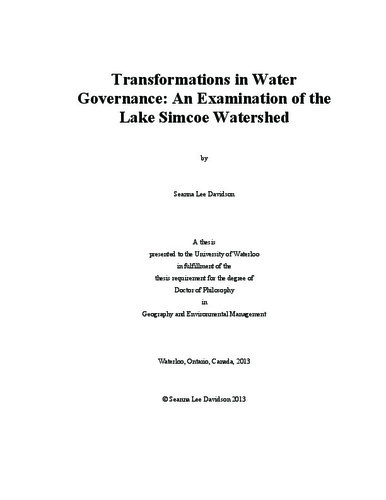| dc.description.abstract | Individuals, communities, non-government organizations and governments are in constant pursuit of intelligent responses to the complex socio-environmental challenges they encounter. The capacity to respond effectively to these contemporary challenges is deeply dependent on the presence of effective governance processes. Governance scholarship has typically been limited to individual elements such as frameworks (hierarchical or market or network), tools (e.g., regulation) or actors (e.g., government). The goal of this thesis is to characterize and explain transformations in water governance in order to offer insight into how more effective governance processes can be created. Transformations in governance speak to the dynamic nature of governing, and highlight the consistent push and pull between, and amongst, the various components at play. Components include actors, formal and informal structures, and the social, economic and environmental contexts in which governance is embedded. Critically each of these components also exists and has influence at multiple levels, adding to the complex and dynamic nature of governance. This research argues that the core elements (frameworks, tools, actors) should be examined individually, as well as collectively, and within context of the various components in order to obtain a holistic perspective on governance process. This holistic perspective is necessary if we are to garner a true understanding of how governance is ultimately designed, contested and transformed.
The research focuses on a large-scale water governance case in southern Ontario that is governed by its own provincial legislation – the first of its kind in Canada. The research examines governance frameworks as situated within the broader architecture, tools, and actor dynamics in the Lake Simcoe watershed and how they evolved over a 30-year period. Interviews, archival research, surveys and social network analyses were utilized in a mixed methods approach. The first governance element examined in this thesis is the architecture of the entire system over the 30 year time period. Rather than conduct a narrow analysis of an individual governance framework in a select period of time, the research takes a high level perspective to identify the transitions between governance frameworks, and the social, economic, and environmental tensions and drivers that initiated change. Particular value is offered by the use of social network analysis to visually identify the structure and statistically evaluate the governance framework at multiple phases in the research period. The second element of governance, tools, is then assessed. Specifically, the utility of a watershed boundary for water governance is examined. The thesis argues that the watershed boundary has value, but should be applied in limited and focus ways, and greater attention should be given to governance processes that transcend the watershed boundary. The final element examined is actors. Early in the thesis, focus is given to the role of government, but in the final section particular attention is given to the role of non-government actors. The research describes how the role and activities of non-government actors has advanced beyond late 20th century approaches, where recent trends display more innovative and entrepreneurial characteristics.
The research offers nine important insights for theory and practice in water governance. (1) Governance processes have the potential to be flexible, adaptive and responsive. (2) A reduced presence of government does not always hold back processes of governance. (3) Existing tools can be re-imagined for new processes. (4) Non-government actors have agency (5) Give attention to individual knowledge and capacity through a distributed governance approach (6) Give attention to time and the building of scientific knowledge (7) Give attention to need for effectively facilitated processes (8) Give attention to emerging opportunity (9) Permits space for creative destruction. Collectively, the findings from this research further develop scholarship on the individual elements of governance, as well as speak to the transformations in water governance as a whole. | en |

